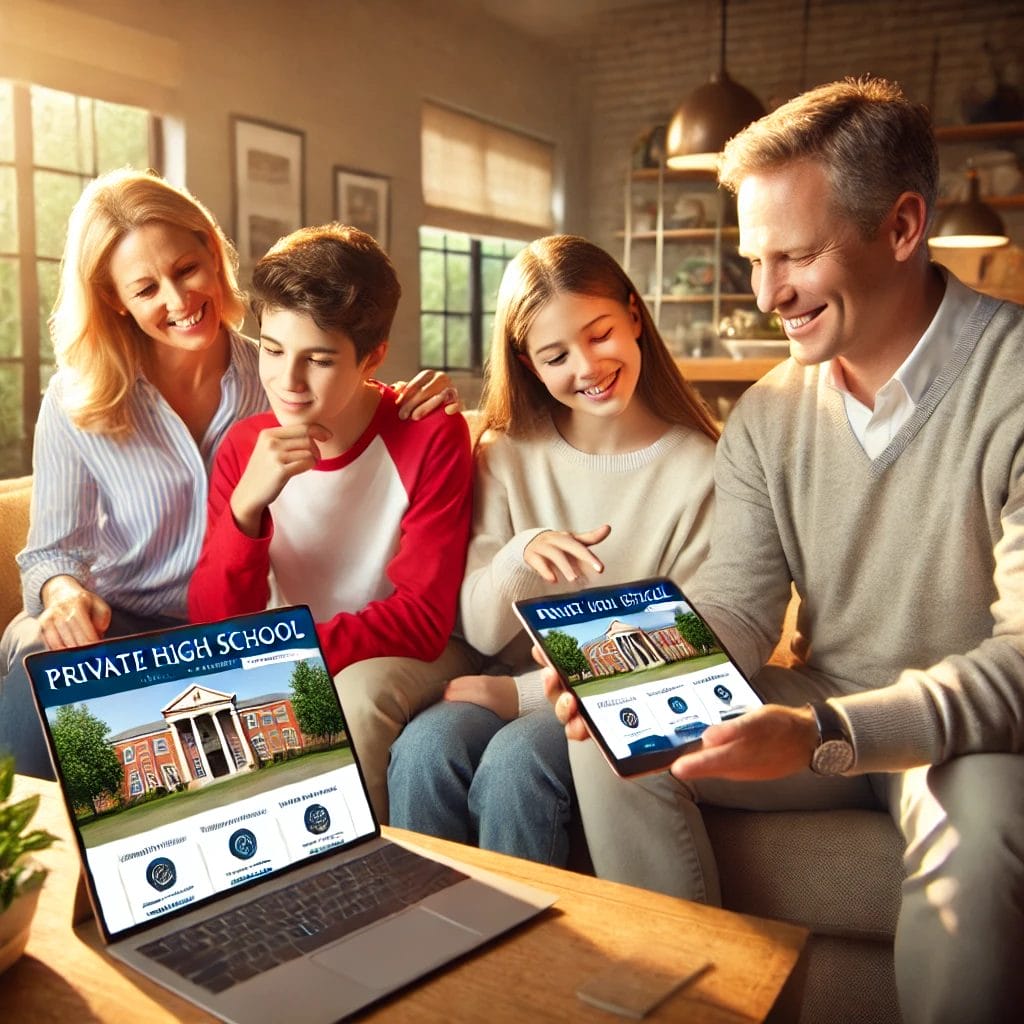Designing a college or university website means creating a site that looks good, works well on phones, and is easy to use. The site should have simple navigation, clear layouts, and strong calls to action to help users find what they need. A good design highlights the school’s academic programs and community strengths in a way that grabs attention and keeps visitors engaged.
What Makes a Great Higher Education Website?
What makes one higher education website design forgettable and another unforgettable?
The answer is simple: easy navigation, great design, and a focus on accessibility.
A good website acts as a front door for future students, shaping their first impression of your school.
Clear, straightforward navigation is key.
Good UX design means a logical layout, clear labels, and interactive features that help visitors find what they need quickly and easily.
This isn’t just a bonus—it’s essential for grabbing the attention of today’s tech-savvy users.
Being mobile-friendly is just as important.
With smartphones now dominating internet use, a mobile-first approach ensures websites load fast, look good, and work smoothly on any handheld device.
By using light, responsive designs, schools can make sure their website looks and works great no matter what screen it’s on.
And don’t overlook the visual side.
Whether for public institutions or private school website design, tools like CSS, first introduced in 1996, made it possible to pair stunning visuals with smart, efficient coding.
The result is web pages that are both eye-catching and functional—a balance of style and usability.
At Clickmill, we bring all these elements together to help schools create standout websites.
Why Design Matters for Higher Education Websites
A great higher education website design does more than just look nice—it’s a key tool for drawing in and engaging students and parents.
Think of it as the school’s digital front door. The way it looks and works shapes how people view the school’s trustworthiness, innovation, and appeal.
To make a strong impression, these websites need to look good and work well.
Clean layouts, balanced colors, and clear fonts show off the school’s brand.
At the same time, features like easy-to-use menus and dynamic tools (such as virtual tours) keep visitors interested while helping them get what they need.
Crafting a professional higher education website design is fundamental to capturing attention and building user confidence.
The way the website is built matters too.
A “mobile-first” design—needed because of the heavy use of phones—makes sure the site looks and works great on any device.
Features like simple menus, clear labels, and accessible content help visitors find answers fast without getting frustrated.
An optimized higher education website design takes all of these elements into account, ensuring seamless navigation and accessibility across platforms.
In short, great design is where creativity meets function.
Whether you’re focusing on higher education website design or a site for private schools, it’s about building a platform that looks good, feels welcoming, and works smoothly.
With Clickmill’s expertise, your school can create a site that impresses and delivers.
Key Features for Higher Education Website Design

Building a higher education website design requires focus, creativity, and prioritizing user experience.
One of the most crucial components is having clear Calls to Action (CTAs).
These are simple prompts like “Apply Now,” “Request Info,” or “Book a Campus Tour.”
They should stand out and be easy to use.
Good CTAs guide visitors seamlessly and help them take the next step.
Every site today needs to work well on mobile devices, but for colleges, this is essential.
A mobile-friendly, responsive design ensures the site looks and functions well on phones and tablets.
With more people using mobile devices, your site must load quickly and run smoothly for optimal on-the-go access.
Your website also requires easy navigation.
Menus should be straightforward and intuitive, allowing visitors to quickly locate information such as academic programs, housing details, or admissions steps.
Tools like CSS (used since the late ’90s) help maintain websites that are clean, accessible, and high-performing.
Finally, interactive features like chatbots, forms, and virtual campus tours enhance engagement.
Whether you’re crafting a site for a university or focusing on private school website design, a user-friendly platform does more than just share facts—it encourages involvement and drives action.
New Trends in Higher Education Website Design
Higher education websites are changing fast to keep up with the digital world.
One big shift is using AI to create personalized experiences for visitors.
Picture this: a student visits your site and instantly sees content just for them, like programs they’re interested in, upcoming events, or application tips.
It’s like having a round-the-clock admissions counselor!
Another exciting trend is virtual tours and video storytelling.
With 360-degree tours, students and their families can walk through your campus from anywhere.
Pair that with a lively video showcasing your school’s vibe—from classes to clubs—and you’ve got a powerful way to grab attention and make a lasting impression.
These features fit perfectly with the mobile-first approach, which focuses on making websites work just as well on smartphones as they do on desktops.
For colleges and private schools, higher education website design isn’t just about being visually appealing—it’s also about creating an interactive, easy-to-use experience.
Great design doesn’t only look good; it converts visitors into engaged users, boosting recruitment for both colleges and private institutions.
How Design Impacts Admissions and Recruitment

A good higher education website design is key to boosting admissions and recruitment in schools.
Think of your website as your school’s first handshake—it needs to make a strong impression on students and their families.
Showcasing programs with easy-to-use tools like program finders, department pages, and eye-catching visuals helps make everything clear and inviting, encouraging action.
Mobile-friendly designs are a must.
With so many people using their phones to browse, a site that’s hard to use on mobile can quickly turn them away.
By creating a design that works well on any device, schools can keep visitors browsing longer and build interest.
Features like virtual tours, personalized content, and simple buttons like “Apply Now” or “Visit Campus” make the admissions process easier.
These interactive elements guide users toward taking the next step.
Good navigation also matters.
If prospective students can quickly find program info, admission requirements, or explore private school website design features like faculty highlights, they’ll feel more confident about applying.
A mix of great design and helpful tools turns your site into a strong recruitment tool.
Higher Education Website Design: Challenges and Solutions
Creating a great website for higher education institutions is about more than good looks.
The trick is balancing personality with professionalism while meeting the varied needs of prospective students and families.
Unlike higher education websites, private school sites tend to focus more on storytelling—showing off academic success, extracurricular activities, and community values.
However, effective higher education website design requires unique strategies to cater to the broader audience of college seekers.
A great higher education website design should connect on an emotional level, giving visitors a feel for the institution’s culture.
Features like virtual campus tours, student success stories, and high-quality event photos can help bring this to life.
Clear navigation and easy-to-use design are also key.
Prospective students and families should be able to find information about admissions and academic programs quickly and easily.
Mobile-friendliness is essential.
With so many users accessing sites from their phones, your site needs to load fast and work well on any device.
Prioritizing mobile optimization is an integral part of modern higher education website design.
At Clickmill, we believe accessibility is non-negotiable.
By combining interactive features, ADA compliance, and SEO, we build higher education website design solutions that don’t just inform—they engage.
We make your institution stand out with designs tailored to your unique strengths.
Want to improve your school’s online presence? Contact Clickmill, and let us help your website shine!
Inspiration: Key Elements of Effective Higher Education Websites

When it comes to higher education website design, some institutions truly excel at balancing aesthetics and user experience.
They create layouts that effortlessly guide users through academic programs and admission details while maintaining visual appeal.
Effective websites often incorporate features like bright visuals, strategic navigation tools, and engaging content to connect with their audience.
For example, showcasing striking photos paired with clean layouts can emphasize the institution’s academic and cultural uniqueness.
Highlighting extracurricular activities and achievements is another great way to engage both students and parents.
What sets these websites apart is their focus on mobile-friendly designs, ensuring accessibility across various devices.
By prioritizing simple, streamlined designs built for smaller screens, they create an experience that’s equally functional on desktops.
Another impactful addition is virtual campus tours, which allow prospective students to explore the campus from anywhere through interactive maps or 360-degree videos.
These features are also essential for private school website design, providing a dynamic way to represent school life and connect with a tech-savvy audience.
Let Clickmill help your school build a website that captures attention, engages visitors, and supports enrollment goals!
Why Accessibility Matters
Web accessibility isn’t just a fancy term; it’s about making sure everyone can use your website.
Think of your school’s online presence as a front door—shouldn’t everyone, no matter their ability, be able to walk through it?
For higher education website design, accessibility isn’t a “nice to have.” It’s a must.
Accessibility means making your site easy for everyone to use, including people with disabilities.
This could mean clear menus for screen readers, alt text for images, or good contrast so text is easy to read.
Laws like the ADA and WCAG guidelines encourage compliance, and non-compliance could lead to legal challenges.
But more than that, being inclusive is simply the right choice.
After all, you don’t want to exclude anyone when trying to attract diverse talent, whether for public universities or even private school website design strategies.
From a design angle, accessibility fits perfectly with today’s focus on mobile-friendly, responsive designs.
These lighter, flexible designs are key as more people use mobile networks.
By making your site accessible, you’re not just ensuring usability—you’re enhancing user experience for everyone.
SEO Tips for Higher Education Websites

To reach prospective students online, your website needs strong content and technical SEO.
Start by improving on-page elements, like titles, descriptions, and headers, to include keywords strategically such as higher education website design.
Focus on ensuring your site is optimized specifically for higher education website design to resonate with the target audience.
Make sure your content flows naturally and matches what people are searching for.
Keep it easy to read and engaging—use short paragraphs, images, and videos that connect with students and parents.
Technical SEO is key.
Your site should have a mobile-friendly, responsive design—a must these days with so many people using their phones to browse.
Make sure it loads fast and meets accessibility standards.
Whether you’re focused on general optimization or higher education website design specifically, adding alt text for images and using clean HTML improves both usability and SEO, boosting your site’s visibility.
Use internal links to help users navigate and increase page authority.
Additionally, leveraging principles from private school website design can inform strategies to create a polished and professional look.
External backlinks also add credibility to your site.
If your school serves a specific area, don’t skip local SEO—include your location info on contact pages and elsewhere.
Create informative, engaging content to bring in visitors.
Blog posts, helpful guides, and program details can organically grow your traffic.
By consistently refining your higher education website design and SEO strategies, you can use tools like Google Analytics to track performance and adjust your approach to keep improving.
Blending Functionality with Design
Creating an effective higher education website design is all about finding the right mix of aesthetics and usability.
A site can’t just look good—it has to function seamlessly, keep users engaged, and ensure easy navigation across devices.
This balance is essential for capturing the interest of prospective students.
The core of a great website lies in its functionality.
Fast load times, intuitive layouts, and smooth navigation prevent visitors from leaving out of frustration.
This is why the “mobile-first” approach is crucial.
With a majority of users accessing content via smartphones and tablets, designs now prioritize smaller screens, ensuring a hassle-free mobile experience before scaling up for desktop.
However, visual appeal also remains important.
The key is to merge consistent branding—think colors, fonts, and imagery—with practical elements like call-to-action buttons and interactive tools.
Techniques like CSS enable the creation of layouts that are both visually appealing and highly functional.
In the end, an effective higher education website shares your school’s unique story while delivering tangible results, such as inquiries and applications.
While the principles may differ slightly for private school website design, the focus on blending style and functionality remains the same.
This union is what sets an exceptional design apart from the rest.
How Analytics Helps Improve Your Website

To stay ahead in the digital world, a higher education website design requires regular updates driven by data.
Analytics acts as a guide, showing schools how to boost user engagement and get more applications.
By tracking key metrics like bounce rates, session times, and clicks, schools can see what’s working and what needs fixing.
A powerful tool in this process is heatmapping.
Heatmaps show where users click, scroll, or stop on the page.
Are they skipping the “Apply Now” button or focusing on an admissions video?
These insights help schools move or redesign parts of the site to get better results.
But analytics isn’t just about numbers.
It’s about understanding your visitors.
Issues like confusing menus or slow-loading pages can push prospective students away.
With analytics, schools can quickly spot these problems and fix them, making it easier for users to stay on the site.
At Clickmill, we simplify all this with custom dashboards that provide real-time data and easy-to-follow insights.
By using a data-driven approach, private school website design or higher education platforms do more than look good—they work better too.
A great site grows and adapts to fit its audience.
How to Kick Off Your Higher Education Website Project
Creating a great higher education website design takes planning and smart choices.
Start by thinking about your school’s main goals. Are you looking to boost enrollment, improve engagement, or highlight your programs? Clear goals help make sure your higher education website design aligns with your school’s mission.
Next, put together a team with members from admissions, marketing, IT, and student services. This way, everyone’s needs and ideas are covered.
Review successful examples of private school website design or higher education website design projects to see what works and what doesn’t. What features stand out? Are there elements you can adapt to meet your own school’s needs?
Focus on what matters most for usability, like easy navigation, mobile-friendly designs, and accessibility.
People expect websites to run smoothly on all devices, especially phones. Keep layouts simple, clean, and fast. Nobody wants to deal with a site that’s slow or hard to use.
Lastly, work with experts like Clickmill, who know how to build exceptional higher education website design solutions.
They mix branding, accessibility, and creativity to craft sites that do more than just meet your needs—they aim to exceed them.
Reach out to learn more about how to turn your vision into a reality.
FAQs
Simple navigation, mobile-friendly layouts, and eye-catching visuals that fit the school’s brand are crucial. These make it easy for future students to find what they need while enjoying a good-looking site.
With so many people using smartphones, students and parents often check school websites on their phones first. A mobile-first design makes sure the site is fast, easy to use, and works well on all devices.
A well-built website makes it easy to learn about programs, apply, and contact admissions. This smooth process can boost applications and improve how people see the school.
Accessibility helps everyone use the site, including people with disabilities. Clear menus, smart coding, and flexible designs make sure all users can get the info they need.
Private school website design can stand out by showcasing unique programs, highlighting community involvement, and using tools like videos or virtual tours. Strong design and a focus on SEO can also ensure the site gets attention and creates a memorable impression.

Responses